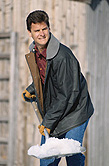
FRIDAY, March 2 (HealthDay News) — Breathing cold air during certain physical activities, such as shoveling snow, increases the body’s demand for oxygen, which may put people with heart disease at greater risk for cardiac arrest or death, a new study finds.
“This study can help us understand why cold air is such a trigger for coronary events,” Lawrence Sinoway, director of the Heart and Vascular Institute at the Pennsylvania State College of Medicine, said in a university news release. “If you are doing some type of isometric work and you’re breathing cold air, your heart is doing more work — it’s consuming more oxygen.”
The researchers used a hand-grip test (which involves participants squeezing a handgrip, a move known to increase blood pressure) to study the heart and lung function of healthy adults in their 20s and 60s while exposed to cold and normal air temperatures. The researchers found a discrepancy in supply and demand in the participants’ left ventricle — the part of the heart that receives oxygenated blood — when cold air was introduced during handgrip exercise. They noted that since the participants’ hearts were healthy, they were able to compensate for this change and continue working properly.
People with heart disease, however, may not be able to keep up with the increased demand for oxygen. The findings, recently published in the Journal of Applied Physiology and The American Journal of Physiology, Heart and Circulatory Physiology, could explain why fatal heart attacks peak during the winter.
Matthew Muller, postdoctoral fellow at Penn State’s Heart and Vascular Institute, said the results were in line with what they expected. “We thought that oxygen demand in the heart would be higher with cold-air breathing, and we also thought that oxygen supply would be a little bit impaired,” he said in the news release. “And that’s generally what we found.”
More information
The U.S. National Heart, Lung, and Blood Institute provides more information on how the human heart works.

